Numerical Study on Humidification Performance of Fuel Cell Test Platform Humidifier
Abstract
:1. Introduction
2. Model Development
2.1. Conservation Equation
- Due to the large size of humidifier and the fast gas flow rate, the standard model is adopted;
- Ignoring the influence of air temperature change in humidifier on air velocity, the air inlet velocity is stable;
- Humidifier shell is adiabatic wall, neglecting the temperature emission;
- The temperature of humidifying water can be maintained continuously.
2.2. Numerical Simulation
2.2.1. Computational Domain and Boundary Condition
2.2.2. Computational Model and Method
3. Results and discussion
3.1. Effect of Air Flow Velocity on Humidification
3.2. Effect of Humidifying Water Temperature on Humidification
3.3. Performance Verification of the Humidifier
4. Conclusions
Author Contributions
Funding
Conflicts of Interest
Nomenclature
| density | |
| time | |
| the components of velocity vectors in the direction | |
| dynamic viscosity | |
| source terms | |
| specific heat capacity | |
| temperature | |
| heat transfer coefficient | |
| ST | viscous dissipation term |
| volume concentration of component s | |
| diffusion coefficient of component s | |
| productivity of component | |
| velocity component | |
| gravitational acceleration | |
| energy of the k-phase fluid | |
| pressure | |
| coordinate direction | |
| saturated vapor pressure | |
| mass of discrete phase | |
| convective heat transfer coefficient | |
| latent heat |
References
- Migliardini, F.; Unich, A.; Corbo, P. Experimental comparison between external and internal humidification in proton exchange membrane fuel cells for road vehicles. Int. J. Hydrogen Energy 2015, 40, 5916–5927. [Google Scholar] [CrossRef]
- Cha, D.; Jeon, S.W.; Yang, W.; Kim, D.; Kim, Y. Comparative performance evaluation of self-humidifying PEMFCs with short-side-chain and long-side-chain membranes under various operating conditions. Energy 2018, 150, 320–328. [Google Scholar] [CrossRef]
- Bernardi, D.M.; Verbrugge, M.W. A mathematical model of the solid polymer-electrolyte fuel cell. J. Electrochem. Soc. 1992, 139, 2477–2491. [Google Scholar] [CrossRef]
- Buechi, F.N.; Srinivasan, S. Operating proton exchange membrane fuel cells without external humidification of the reactant gases. J. Electrochem. Soc. 1997, 144, 2767–2772. [Google Scholar] [CrossRef]
- Choi, K.H.; Park, D.J.; Rho, Y.W.; Kho, Y.T.; Lee, T.H. A study of the internal humidification of an integrated PEMFC stack. J. Power Sources 1998, 74, 146–150. [Google Scholar] [CrossRef]
- Staschewski, D. Internal humidifying of PEM fuel cells. Int. J. Hydrogen Energy 1996, 21, 381–385. [Google Scholar] [CrossRef]
- Vasu, G.; Tangirala, A.K.; Viswanathan, B.; Dhathathreyan, K.S. Continuous bubble humidification and control of relative humidity of H for a PEMFC system. Int. J. Hydrogen Energy 2008, 33, 4640–4648. [Google Scholar] [CrossRef]
- Nikiforow, K.; Ihonen, J.; Keranen, T.; Karimaki, H.; Alopaeus, V. Modeling and experimental validation of H2 gas bubble humidifier for a 50 kW stationary PEMFC system. Int. J. Hydrogen Energy 2014, 39, 9768–9781. [Google Scholar] [CrossRef]
- Kuhn, R.; Manke, I.; Hartnig, C.; Krüger, P.; Kleinau, S.; Dawson, M.; Geyer, J.; Roscher, M. Dynamic fuel cell gas humidification system. Int. J. Hydrogen Energy 2012, 37, 7702–7709. [Google Scholar] [CrossRef]
- Hyun, D.; Kim, J. Study of external humidification method in proton exchange membrane fuel cell. J. Power Sources 2004, 126, 98–103. [Google Scholar] [CrossRef]
- Casalegno, A.; Antonellis, S.D.; Colombo, L.; Rinaldi, F. Design of an innovative enthalpy wheel based humidification system for polymer electrolyte fuel cell. Int. J. Hydrogen Energy 2011, 36, 5000–5009. [Google Scholar] [CrossRef]
- Jung, S.H.; Kim, S.L.; Min, S.K.; Park, Y.; Lim, T.W. Experimental study of gas humidification with injectors for automotive PEM fuel cell systems. J. Power Sources 2007, 170, 324–333. [Google Scholar] [CrossRef]
- Sung, C.C.; Bai, C.Y.; Chang, S.J.; Chen, J.H. Controllable fuel cell humidification by ultrasonic atomization. J. Power Sources 2013, 239, 151–156. [Google Scholar] [CrossRef]
- Yan, W.M.; Chen, C.Y.; Jhang, Y.K.; Chang, Y.H.; Amani, P.; Amani, M. Performance evaluation of a multi-stage plate-type membrane humidifier for proton exchange membrane fuel cell. Energy Convers. Manage. 2018, 176, 123–130. [Google Scholar] [CrossRef]
- Chen, C.Y.; Chang, Y.H.; Li, C.H.; Chang, C.C.; Yan, W.M. Physical properties measurement and performance comparison of membranes for planar membrane humidifiers. Int. J. Heat Mass Transfer 2019, 136, 393–403. [Google Scholar] [CrossRef]
- Chang, Y.; Qin, Y.; Yin, Y.; Zhang, J.; Li, X. Humidification strategy for polymer electrolyte membrane fuel cells—A review. Appl. Energy 2018, 230, 643–662. [Google Scholar] [CrossRef]
- Hwang, J.J.; Hwang, H.S. Parametric studies of a double-cell stack of PEMFC using Grafoil™ flow-field plates. J. Power Sources 2002, 104, 24–32. [Google Scholar] [CrossRef]
- Hsieh, S.S.; Yang, S.H.; Kuo, J.K.; Huang, C.F.; Tsai, H.H. Study of operational parameters on the performance of micro PEMFCs with different flow fields. Energy Convers. Manage. 2006, 47, 1868–1878. [Google Scholar] [CrossRef]
- Williams, M.V.; Kunz, H.R.; Fenton, J.M. Operation of Nafion®-based PEM fuel cells with no external humidification: Influence of operating conditions and gas diffusion layers. J. Power Sources 2004, 135, 122–134. [Google Scholar] [CrossRef]
- Santarelli, M.G.; Torchio, M.F. Experimental analysis of the effects of the operating variables on the performance of a single PEMFC. Energy Convers. Manage. 2007, 48, 40–51. [Google Scholar] [CrossRef]
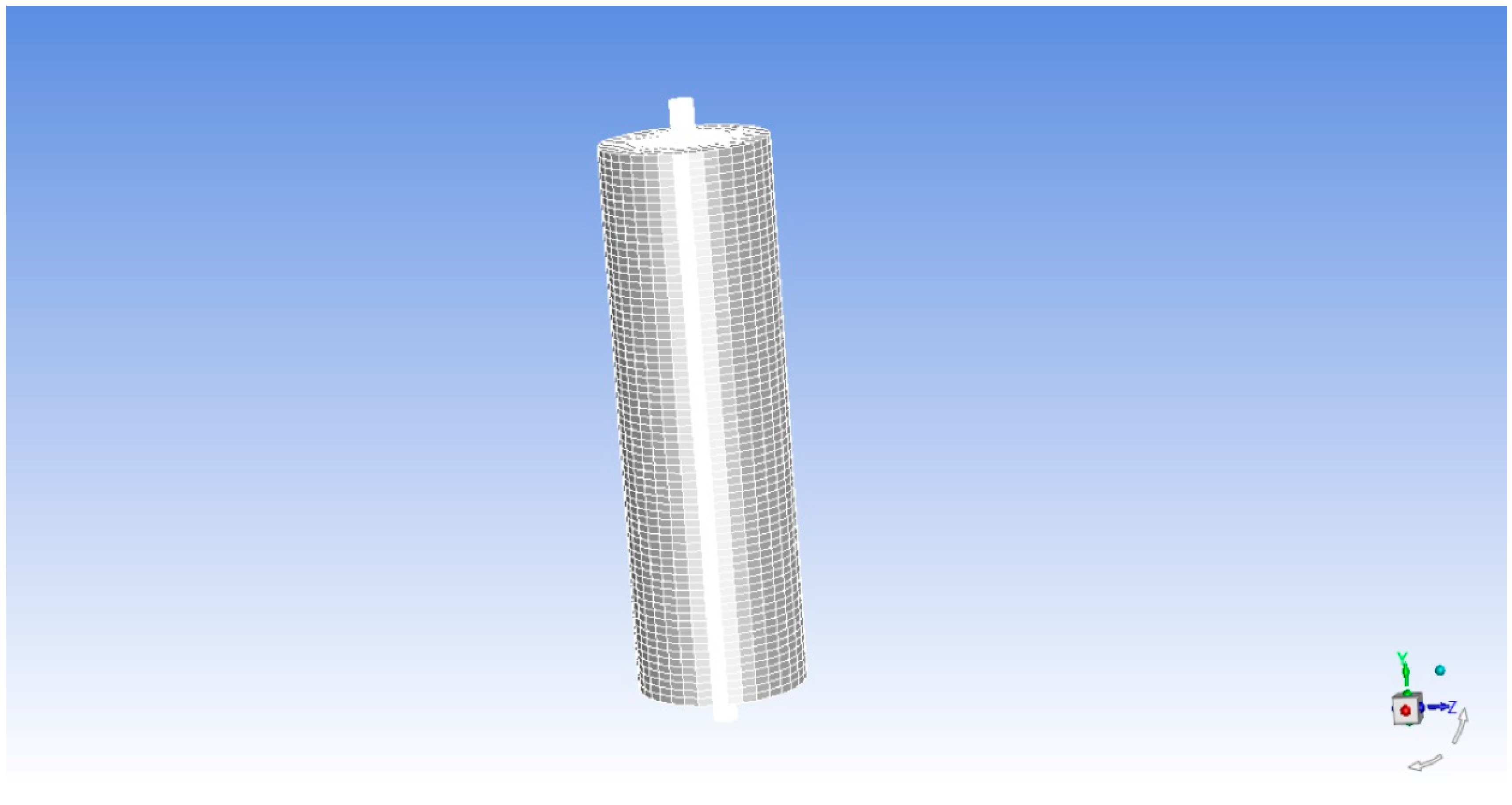

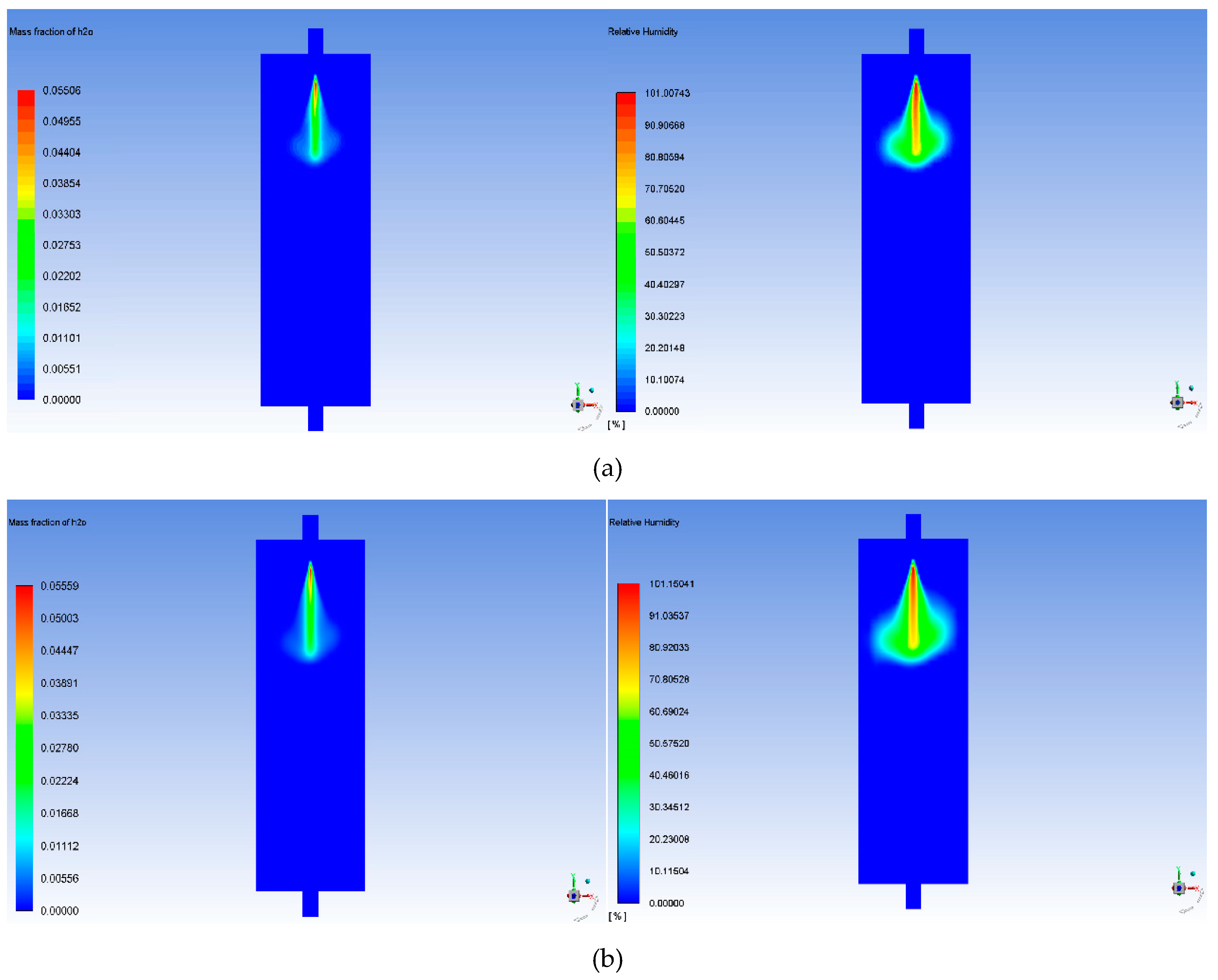
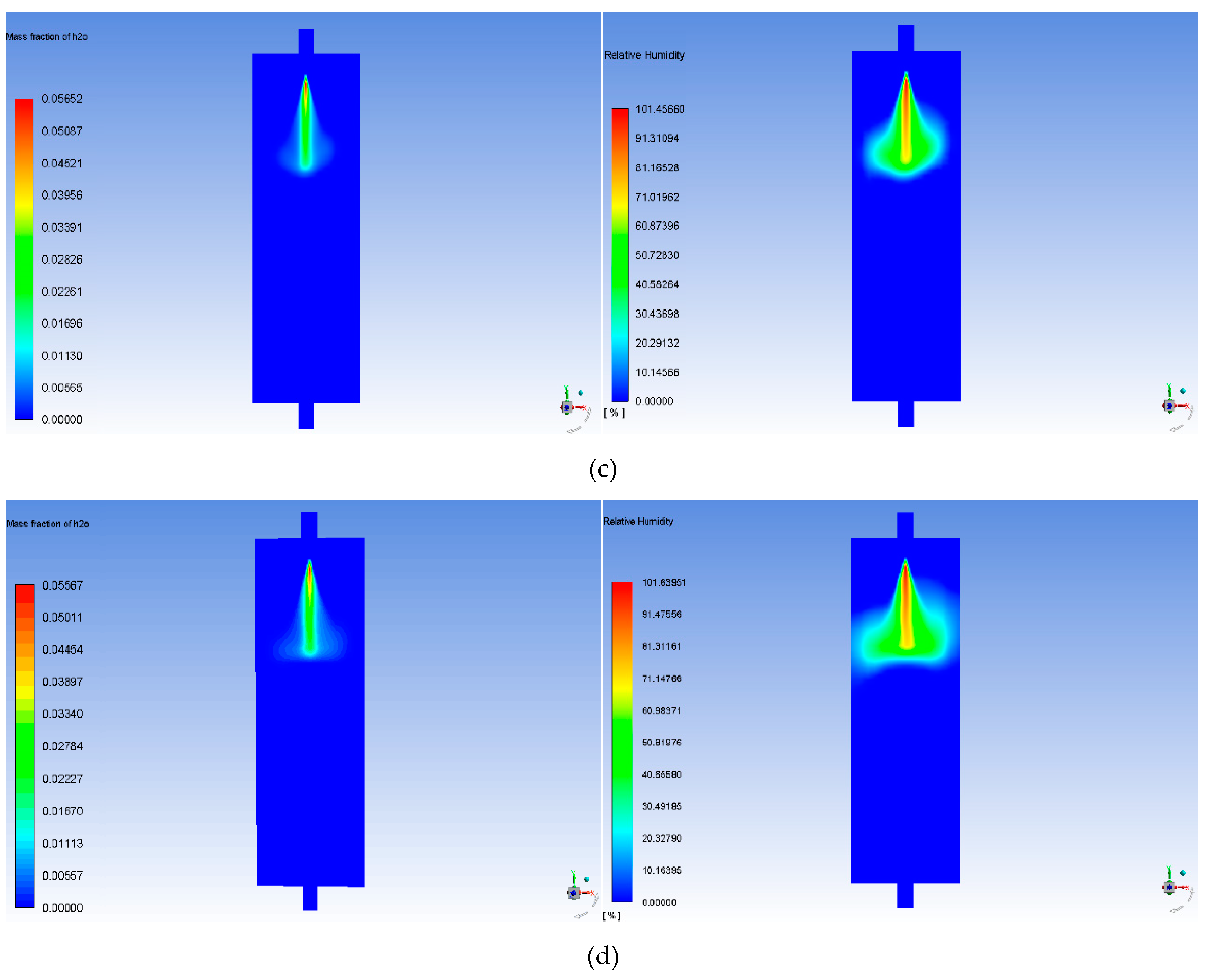

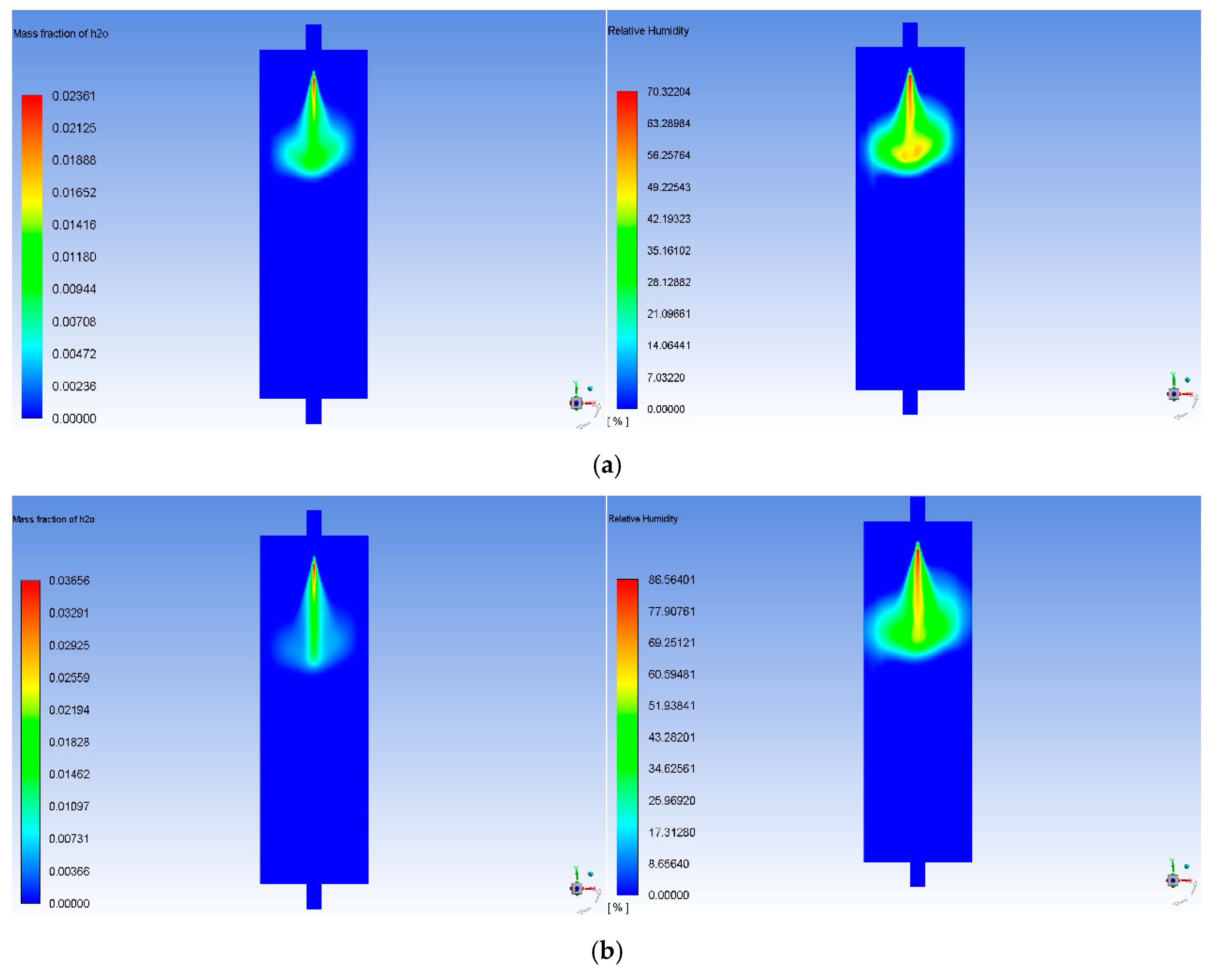
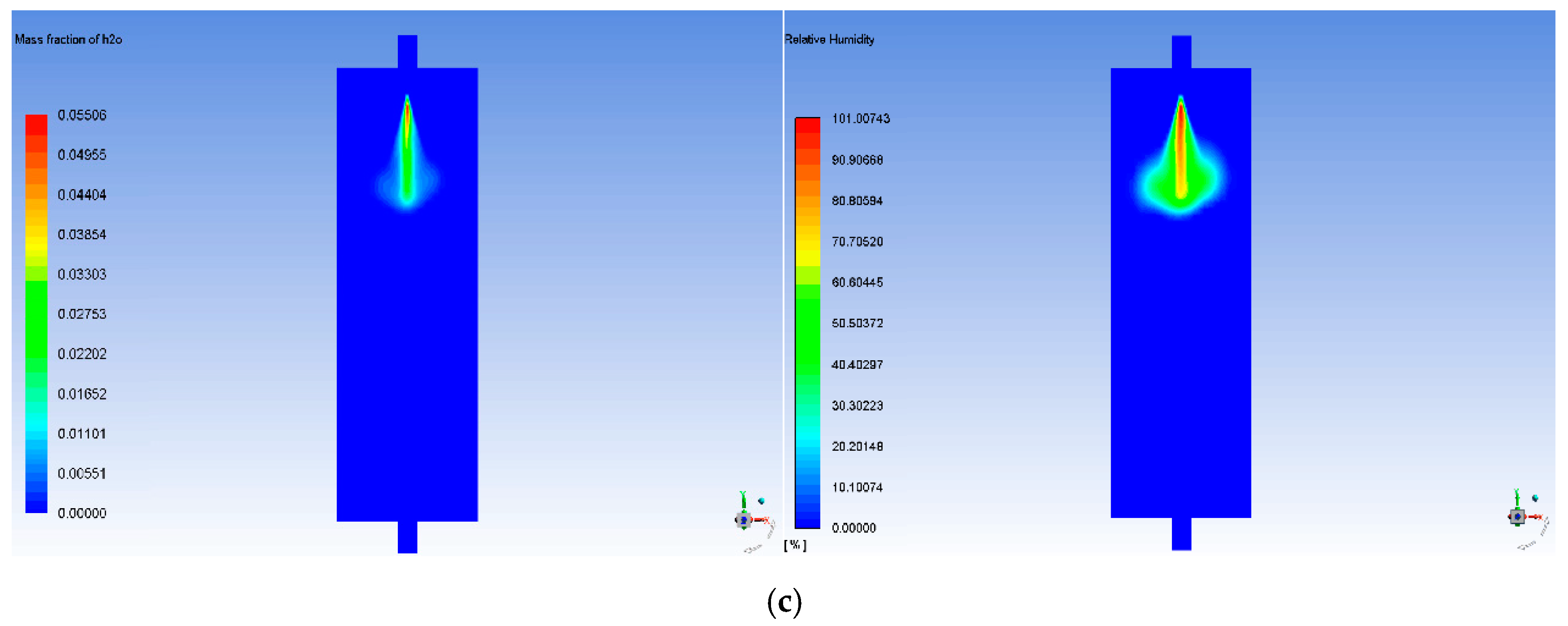

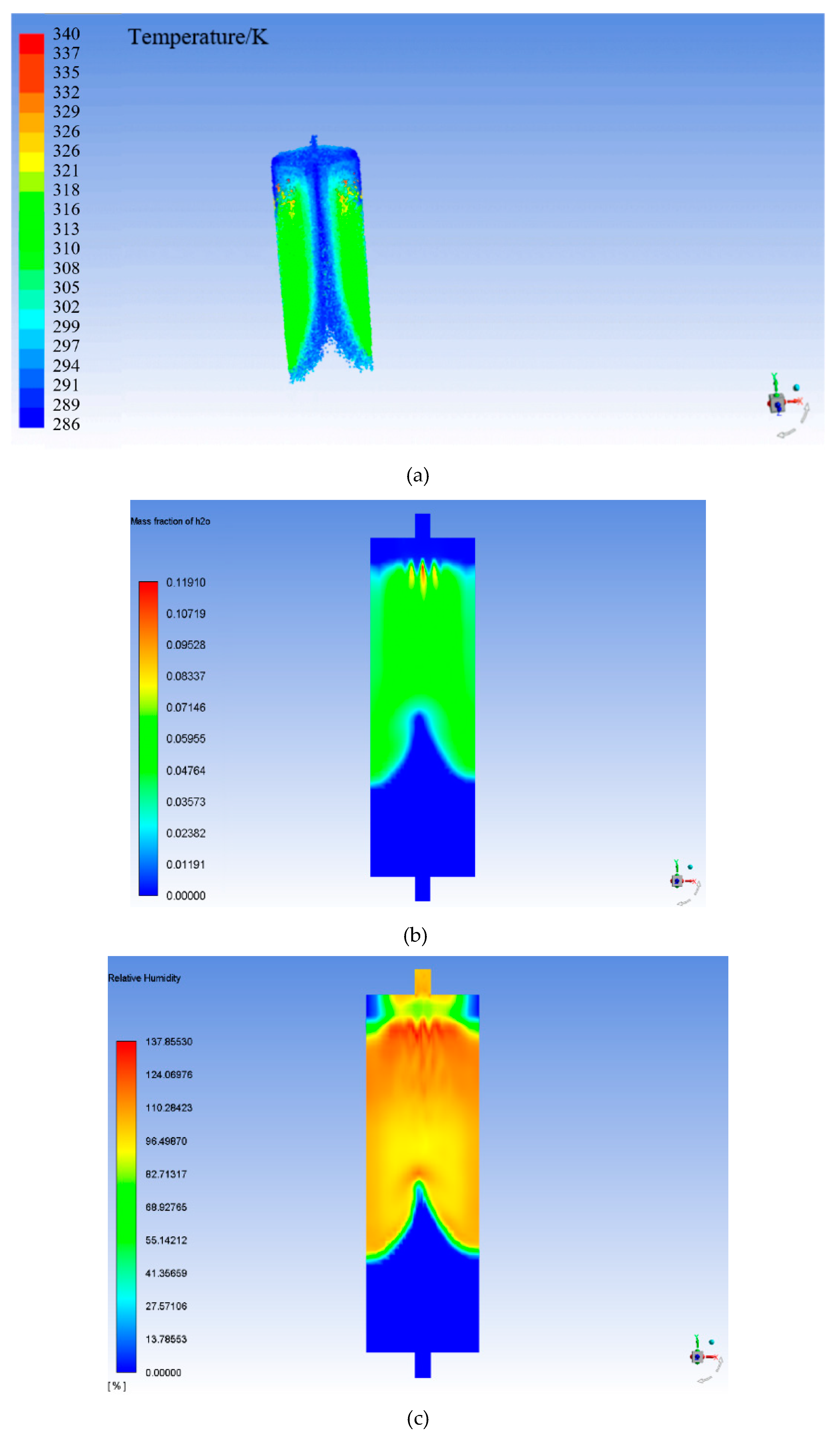
| Parameters | Value |
|---|---|
| diameter | 230 mm |
| height | 700 mm |
| diameter of inlet and outlet | 32 mm |
| length of inlet and outlet | 50 mm |
| inlet air velocity | 5 m∙s−1, 10 m∙s−1, 15 m∙s−1,20 m∙s−1 |
| humidifying water temperature | 50 °C, 60 °C, 70 °C |
| water pressure | 300 kPa |
| water flow rate | 1 m∙s−1 |
| diameter of the spray particles | 1 mm |
| spray angle | 60 degrees |
© 2019 by the authors. Licensee MDPI, Basel, Switzerland. This article is an open access article distributed under the terms and conditions of the Creative Commons Attribution (CC BY) license (http://creativecommons.org/licenses/by/4.0/).
Share and Cite
Ma, T.; Wang, K.; Zhou, Q.; Lin, W.; Cong, M.; Jia, W. Numerical Study on Humidification Performance of Fuel Cell Test Platform Humidifier. Energies 2019, 12, 3839. https://doi.org/10.3390/en12203839
Ma T, Wang K, Zhou Q, Lin W, Cong M, Jia W. Numerical Study on Humidification Performance of Fuel Cell Test Platform Humidifier. Energies. 2019; 12(20):3839. https://doi.org/10.3390/en12203839
Chicago/Turabian StyleMa, Tiancai, Kai Wang, Qiongqiong Zhou, Weikang Lin, Ming Cong, and Wenya Jia. 2019. "Numerical Study on Humidification Performance of Fuel Cell Test Platform Humidifier" Energies 12, no. 20: 3839. https://doi.org/10.3390/en12203839
APA StyleMa, T., Wang, K., Zhou, Q., Lin, W., Cong, M., & Jia, W. (2019). Numerical Study on Humidification Performance of Fuel Cell Test Platform Humidifier. Energies, 12(20), 3839. https://doi.org/10.3390/en12203839






